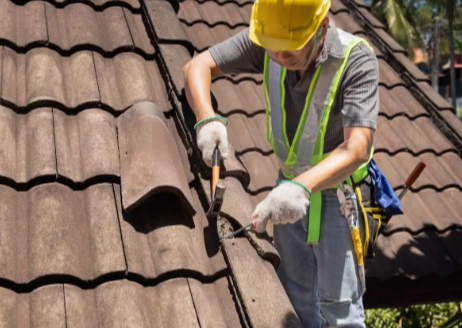Avoid These 7 Common Roof Replacement Mistakes

Replacing your roof is a big investment that protects your home, boosts curb appeal, and can save energy. But it’s complex, and many homeowners make mistakes that lead to expensive repairs and a shorter roof lifespan. This guide will cover seven common errors to avoid, helping you protect your investment and get a durable, high-quality roof.
Mistake 1: Not Hiring a Qualified Contractor
The single biggest mistake you can make is choosing the wrong person for the job. An unqualified or dishonest contractor can turn your roof replacement into a nightmare of poor workmanship, legal issues, and unexpected costs. To avoid this, thorough research is non-negotiable.
Do Your Homework
Start by vetting potential contractors. A reputable professional should be able to provide proof of the following without hesitation:
- License: Verify that their contractor’s license is active and in good standing with your state or local licensing board. This confirms they have met the minimum requirements to operate legally.
- Insurance: Ensure they have both general liability insurance and workers’ compensation. Liability insurance protects your property from damage, while workers’ compensation covers their crew in case of injury on your property. Without it, you could be held liable for accidents.
Get Multiple Quotes and Check Reviews
Don’t settle for the first quote you receive. Contact at least three different roofing companies to get a detailed, written estimate for the project. This allows you to compare costs, materials, and timelines. Be wary of any bid that is significantly lower than the others, as it may indicate subpar materials or rushed work.
Finally, dive into online reviews and ask for references. See what past customers have to say on platforms like Google, Yelp, and the Better Business Bureau. Speaking directly with previous clients can give you unfiltered insight into the contractor’s professionalism, communication, and quality of work.
Mistake 2: Neglecting to Obtain Necessary Permits
“Do I really need a permit for this?” It’s a common question, and for a major project like a roof replacement, the answer is almost always yes. Skipping this step to save time or money is a risky gamble that can lead to serious consequences.
Building permits exist to ensure the work meets local safety codes and standards. A permit triggers inspections at critical stages of the project, verifying that the installation is done correctly. Failing to obtain one can result in hefty fines, forced removal of the new roof, and major problems when you eventually sell your home. A professional contractor will handle the permitting process as part of their service. If a contractor suggests skipping it, consider that a major red flag.
Mistake 3: Choosing the Wrong Materials
Your roof is more than just a cover; it’s a system designed to work with your home’s architecture and local climate. Selecting materials based solely on price or aesthetics can lead to poor performance and premature failure.
Consider these factors when choosing roofing materials:
- Climate: If you live in a hot, sunny region, you might consider reflective shingles that can lower cooling costs. In areas with heavy snowfall or hail, impact-resistant materials are a wise choice.
- Roof Style: The pitch and style of your roof can limit your material options. For example, some materials are not suitable for low-slope roofs.
- Budget and Longevity: While asphalt shingles are budget-friendly, materials like metal or slate cost more upfront but can last significantly longer. Balance your initial budget with the long-term value.
Mistake 4: Ignoring Ventilation Issues
A roof needs to breathe. Proper attic ventilation is crucial for regulating temperature and moisture levels in your home. Without it, heat can get trapped in the summer, increasing your energy bills and baking your shingles from the inside out. In the winter, warm, moist air can cause condensation, leading to mold, mildew, and rot in your roof deck.
An experienced contractor will assess your current ventilation system—including soffit, ridge, and gable vents—and recommend improvements if necessary. A well-ventilated roof system will last longer and contribute to a healthier, more energy-efficient home.
Mistake 5: Overlooking the Importance of Gutters
Gutters are an essential part of your roofing system, responsible for directing water away from your home’s foundation, siding, and landscaping. A roof replacement is the perfect time to evaluate the condition of your gutters.
If your gutters are old, damaged, or improperly sized for your new roof, they won’t be able to handle the water runoff effectively. This can lead to soil erosion, basement flooding, and foundation damage. Discuss rain gutter installations like those in Salt Lake City with your contractor to see if an upgrade is needed. Installing new gutters or high-quality gutter covers along with your new roof ensures the entire system works together seamlessly to protect your home.
Mistake 6: Cutting Corners on Underlayment
The underlayment is a water-resistant barrier installed directly onto the roof deck, beneath the shingles. While it’s hidden from view, it serves as a critical secondary layer of protection against water intrusion.
Some homeowners or contractors may be tempted to use cheap, low-quality felt or even skip the underlayment in certain areas to cut costs. This is a mistake. A high-quality synthetic underlayment offers superior tear resistance and water protection, especially against wind-driven rain and ice dams. Insisting on a quality underlayment is a small price to pay for long-term peace of mind.
Mistake 7: Not Inspecting the Attic
The work isn’t finished just because the last shingle is in place. A final inspection from inside the attic is crucial to catch any potential issues. Before the project, an attic inspection can reveal hidden leaks, water-damaged wood, or ventilation problems that need to be addressed.
After the replacement, a thorough look from below is just as important. Check the underside of the roof deck for any new daylight peeking through, which could indicate a missed nail or a gap in the decking. This final check ensures the job was done right and helps you catch small problems before they become major leaks.
Conclusion
Now that you know the importance of roof inspections and replacements, it’s time to take action. Contact a trusted roofing contractor today to schedule an inspection and discuss any necessary repairs or replacements. Regular maintenance and timely replacements can save you money in the long run and keep your home safe and secure for years to come.



